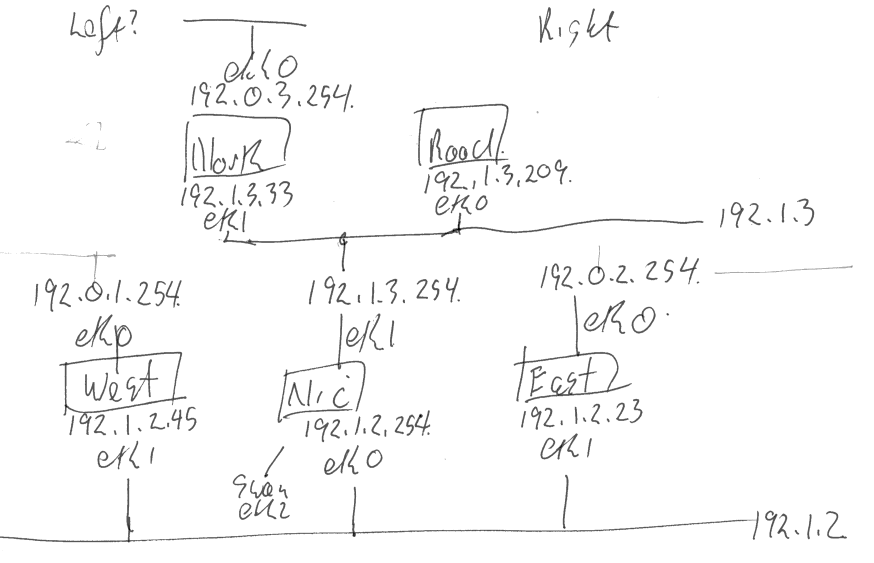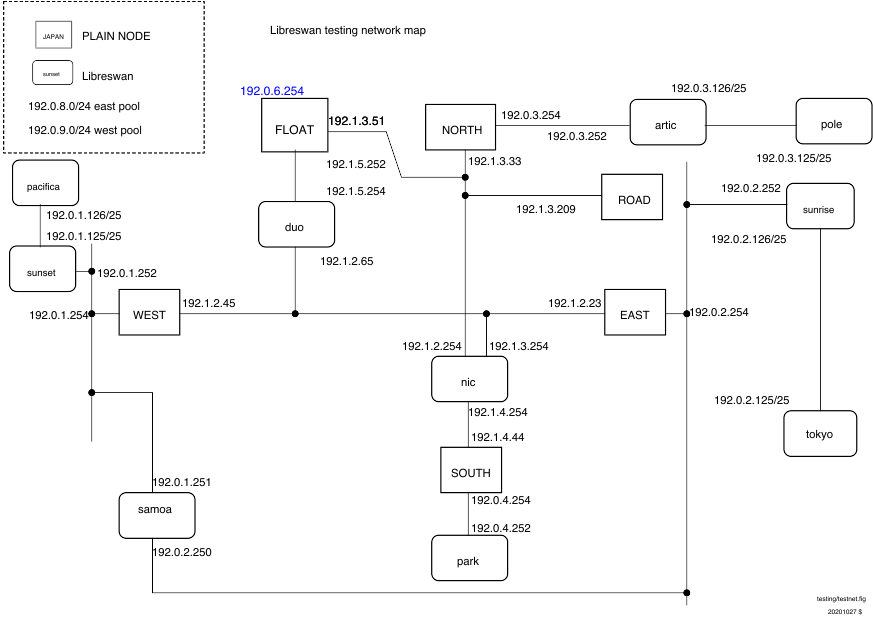Test Suite: Difference between revisions
Jump to navigation
Jump to search
(delete performance stuff) |
(shuffle) |
||
| (37 intermediate revisions by 2 users not shown) | |||
| Line 1: | Line 1: | ||
== Running tests == | |||
The libreswan tests, in testing/pluto, can be run using several different mechanisms: | |||
{ | {| class="wikitable" | ||
|+ Test Frameworks | |||
! Framework | |||
! Speed | |||
! Host | |||
! Guest | |||
! Modifies / | |||
! Notes | |||
|- style="vertical-align:top;" | |||
| [[Test Suite - Namespace | Namespaces]] | |||
| fast | |||
| linux | |||
| linux | |||
| yes | |||
| results are host dependent (for instance the host's kernel version)<br>requires all dependencies, including libreswan, to be installed on / <br> no systemd tests | |||
|- style="vertical-align:top;" | |||
| [[Test Suite - KVM | KVM]] | |||
| slower | |||
| generic? | |||
| Fedora, FreeBSD, NetBSD, OpenBSD | |||
| no | |||
| in theory it can be run on any system supporting libvirt/KVM (but only Linux has ever been used) | |||
|- style="vertical-align:top;" | |||
| [[Test Suite - Docker | Docker]] | |||
| | |||
| linux | |||
| | |||
| | |||
| Linux centric using host kernel.<br>Ideal for build tests.<br>Can build using various Linux Distributions : CentOS 6, 7, 8, Fedora 28 - rawhide, Debian, Ubuntu.<br>Also for run tests using systemd. | |||
|} | |||
== How tests work == | |||
All the test cases involving VMs are located in the libreswan directory under <tt>testing/pluto/</tt>. The most basic test case is called basic-pluto-01. Each test case consists of a few files: | |||
All the test cases involving VMs are located in the libreswan directory under testing/pluto/ . The most basic test case is called basic-pluto-01. Each test case consists of a few files: | |||
* description.txt to explain what this test case actually tests | * description.txt to explain what this test case actually tests | ||
| Line 373: | Line 46: | ||
* Known good (sanitized) output for each VM (eg west.console.txt, east.console.txt) | * Known good (sanitized) output for each VM (eg west.console.txt, east.console.txt) | ||
* testparams.sh if there are any non-default test parameters | * testparams.sh if there are any non-default test parameters | ||
Once the test run has completed, you will see an OUTPUT/ directory in the test case directory: | Once the test run has completed, you will see an OUTPUT/ directory in the test case directory: | ||
| Line 416: | Line 63: | ||
* Any core dumps generated if a pluto daemon crashed | * Any core dumps generated if a pluto daemon crashed | ||
; testing/baseconfigs/ | |||
: configuration files installed on guest machines | |||
; testing/guestbin/ | |||
: shell scripts used by tests, and run on the guest | |||
; testing/linux-system-roles.vpn/ | |||
: ??? | |||
; testing/packaging/ | |||
: ??? | |||
; testing/pluto/TESTLIST | |||
: list of tests, and their expected outcome | |||
; testing/pluto/*/ | |||
: individual test directories | |||
; testing/programs/ | |||
: executables used by tests, and run on the guest | |||
; testing/sanitizers/ | |||
: filters for cleaning up the test output | |||
; testing/utils/ | |||
: test drivers and other host tools | |||
; testing/x509/ | |||
: certificates, scripts are run on a guest | |||
== | == Network Diagrams == | ||
=== Fine Print === | |||
* interface-0 (eth0, vio0, vioif0) is connected to SWANDEFAULT which has a NAT gateway to the internet | |||
** the exceptions are the Fedora test domains: EAST, WEST, ROAD, NORTH; should they? | |||
** the BSD domains always up inteface-0 so that /pool, /source, and /testing can be NFS mounted | |||
** NIC needs to run DHCP on eth0 manually; how? | |||
** transmogrify does not try to modify interface-0(SWANDEFAULT) (it breaks established network sessions such as NFS) | |||
( | * the interface names do not have consistent order (see comment above about Fedora's interface-0 not pointing at SWANDEFAULT) | ||
** Fedora has ethN | |||
** OpenBSD has vioN (different order) | |||
** NetBSD has vioifN (different order) | |||
=== Network Diagram === | |||
LEFT RIGHT | |||
192.0.3.0/24 -----+-------------------------------+-- 2001:db8:0:3::/64 | |||
| | |||
2001:db8:0:3::254 | |||
192.0.3.254(eth0) | |||
ROAD NORTH | |||
192.1.3.209(eth0) 192.1.3.33(eth1) | |||
2001:db8:1:3::209 2001:db8:1:3::33 | |||
| | | |||
192.1.3.0/254 ----+----------------+--------------+-- 2001:db8:1:3::/64 | |||
| | |||
2001:db8:1:3::254 | |||
192.1.3.254(eth2) | |||
NIC---swandefault(0) | |||
192.1.2.254(eth1) | |||
2001:db8:1:2::254 | |||
| | |||
192.1.2.0/24 ---+------------------+-------------+--- 2001:db8:1:2::/64 | |||
| | | |||
2001:db8:1:2::45 2001:db8:1:2::23 | |||
192.1.2.45(eth1) 192.1.2.23(eth1) | |||
WEST---[swandefault(0)] EAST---[swandefault(0)] | |||
192.0.1.254(eth0/viof2) 192.0.2.254(eth0/viof2) | |||
2001:db8:0:1::254 2001:db8:0:2::254 | |||
| | | |||
| 192.0.2.0/255 ---+--- 2001:db8:0:2::/64 | |||
| | |||
192.0.1.0/255 --+------------------------------------ 2001:db8:0:1::/64 | |||
192.1.4.0/255 --------------------------------------- 2001:db8:1:4::/64 | |||
=== | === Proposed Network Diagram: add train + noc === | ||
LEFT RIGHT | |||
.-----ROAD-----. TRAIN | |||
192.1.3.209(eth0) | | | |||
2001:db8:1:3::209 | | | |||
| | | | |||
192.0.3.0/24 ----|--------------+----+------------+-- 2001:db8:0:3::/64 | |||
| | | |||
| 2001:db8:0:3::254 | |||
| 192.0.3.254(eth0) | |||
| NORTH | |||
| 192.1.3.33(eth1) | |||
| 2001:db8:1:3::33 | |||
| | | |||
192.1.3.0/254 ---+--+----------------+---------+----- 2001:db8:1:3::/64 | |||
| | | |||
2001:db8:1:3::254 2001:db8:1:3::253 | |||
192.1.3.254(eth2) 192.1.3.253(eth2) | |||
NIC---swandefault(0) NOC---swandefault(0) | |||
192.1.2.254(eth1) 192.1.2.253(eth1) | |||
2001:db8:1:2::254 2001:db8:1:2::253 | |||
| | | |||
192.1.2.0/24 ---+---+--------------------------+-+--- 2001:db8:1:2::/64 | |||
| | | |||
2001:db8:1:2::45 2001:db8:1:2::23 | |||
192.1.2.45(eth1) 192.1.2.23(eth1) | |||
WEST---[swandefault(0)] EAST---[swandefault(0)] | |||
192.0.1.254(eth0/viof2) 192.0.2.254(eth0/viof2) | |||
2001:db8:0:1::254 2001:db8:0:2::254 | |||
| | | |||
| 192.0.2.0/255 ---+--- 2001:db8:0:2::/64 | |||
| | |||
192.0.1.0/255 --+------------------------------------ 2001:db8:0:1::/64 | |||
192.1.4.0/255 --------------------------------------- 2001:db8:1:4::/64 | |||
=== Older diagrams === | |||
==== Hand Sketch of Current Network ==== | |||
[[File:networksketch.png]] | |||
==== Original Network Diagram ==== | |||
[[File:testnet.png]] | |||
== | |||
== | |||
Revision as of 22:09, 29 July 2022
Running tests
The libreswan tests, in testing/pluto, can be run using several different mechanisms:
| Framework | Speed | Host | Guest | Modifies / | Notes |
|---|---|---|---|---|---|
| Namespaces | fast | linux | linux | yes | results are host dependent (for instance the host's kernel version) requires all dependencies, including libreswan, to be installed on / no systemd tests |
| KVM | slower | generic? | Fedora, FreeBSD, NetBSD, OpenBSD | no | in theory it can be run on any system supporting libvirt/KVM (but only Linux has ever been used) |
| Docker | linux | Linux centric using host kernel. Ideal for build tests. Can build using various Linux Distributions : CentOS 6, 7, 8, Fedora 28 - rawhide, Debian, Ubuntu. Also for run tests using systemd. |
How tests work
All the test cases involving VMs are located in the libreswan directory under testing/pluto/. The most basic test case is called basic-pluto-01. Each test case consists of a few files:
- description.txt to explain what this test case actually tests
- ipsec.conf files - for host west is called west.conf. This can also include configuration files for strongswan or racoon2 for interop testig
- ipsec.secret files - if non-default configurations are used. also uses the host syntax, eg west.secrets, east.secrets.
- An init.sh file for each VM that needs to start (eg westinit.sh, eastinit.sh, etc)
- One run.sh file for the host that is the initiator (eg westrun.sh)
- Known good (sanitized) output for each VM (eg west.console.txt, east.console.txt)
- testparams.sh if there are any non-default test parameters
Once the test run has completed, you will see an OUTPUT/ directory in the test case directory:
$ ls OUTPUT/ east.console.diff east.console.verbose.txt RESULT west.console.txt west.pluto.log east.console.txt east.pluto.log swan12.pcap west.console.diff west.console.verbose.txt
- RESULT is a text file (whose format is sure to change in the next few months) stating whether the test succeeded or failed.
- The diff files show the differences between this testrun and the last known good output.
- Each VM's serial (sanitized) console log (eg west.console.txt)
- Each VM's unsanitized verbose console output (eg west.console.verbose.txt)
- A network capture from the bridge device (eg swan12.pcap)
- Each VM's pluto log, created with plutodebug=all (eg west.pluto.log)
- Any core dumps generated if a pluto daemon crashed
- testing/baseconfigs/
- configuration files installed on guest machines
- testing/guestbin/
- shell scripts used by tests, and run on the guest
- testing/linux-system-roles.vpn/
- ???
- testing/packaging/
- ???
- testing/pluto/TESTLIST
- list of tests, and their expected outcome
- testing/pluto/*/
- individual test directories
- testing/programs/
- executables used by tests, and run on the guest
- testing/sanitizers/
- filters for cleaning up the test output
- testing/utils/
- test drivers and other host tools
- testing/x509/
- certificates, scripts are run on a guest
Network Diagrams
Fine Print
- interface-0 (eth0, vio0, vioif0) is connected to SWANDEFAULT which has a NAT gateway to the internet
- the exceptions are the Fedora test domains: EAST, WEST, ROAD, NORTH; should they?
- the BSD domains always up inteface-0 so that /pool, /source, and /testing can be NFS mounted
- NIC needs to run DHCP on eth0 manually; how?
- transmogrify does not try to modify interface-0(SWANDEFAULT) (it breaks established network sessions such as NFS)
- the interface names do not have consistent order (see comment above about Fedora's interface-0 not pointing at SWANDEFAULT)
- Fedora has ethN
- OpenBSD has vioN (different order)
- NetBSD has vioifN (different order)
Network Diagram
LEFT RIGHT
192.0.3.0/24 -----+-------------------------------+-- 2001:db8:0:3::/64
|
2001:db8:0:3::254
192.0.3.254(eth0)
ROAD NORTH
192.1.3.209(eth0) 192.1.3.33(eth1)
2001:db8:1:3::209 2001:db8:1:3::33
| |
192.1.3.0/254 ----+----------------+--------------+-- 2001:db8:1:3::/64
|
2001:db8:1:3::254
192.1.3.254(eth2)
NIC---swandefault(0)
192.1.2.254(eth1)
2001:db8:1:2::254
|
192.1.2.0/24 ---+------------------+-------------+--- 2001:db8:1:2::/64
| |
2001:db8:1:2::45 2001:db8:1:2::23
192.1.2.45(eth1) 192.1.2.23(eth1)
WEST---[swandefault(0)] EAST---[swandefault(0)]
192.0.1.254(eth0/viof2) 192.0.2.254(eth0/viof2)
2001:db8:0:1::254 2001:db8:0:2::254
| |
| 192.0.2.0/255 ---+--- 2001:db8:0:2::/64
|
192.0.1.0/255 --+------------------------------------ 2001:db8:0:1::/64
192.1.4.0/255 --------------------------------------- 2001:db8:1:4::/64
Proposed Network Diagram: add train + noc
LEFT RIGHT
.-----ROAD-----. TRAIN
192.1.3.209(eth0) | |
2001:db8:1:3::209 | |
| | |
192.0.3.0/24 ----|--------------+----+------------+-- 2001:db8:0:3::/64
| |
| 2001:db8:0:3::254
| 192.0.3.254(eth0)
| NORTH
| 192.1.3.33(eth1)
| 2001:db8:1:3::33
| |
192.1.3.0/254 ---+--+----------------+---------+----- 2001:db8:1:3::/64
| |
2001:db8:1:3::254 2001:db8:1:3::253
192.1.3.254(eth2) 192.1.3.253(eth2)
NIC---swandefault(0) NOC---swandefault(0)
192.1.2.254(eth1) 192.1.2.253(eth1)
2001:db8:1:2::254 2001:db8:1:2::253
| |
192.1.2.0/24 ---+---+--------------------------+-+--- 2001:db8:1:2::/64
| |
2001:db8:1:2::45 2001:db8:1:2::23
192.1.2.45(eth1) 192.1.2.23(eth1)
WEST---[swandefault(0)] EAST---[swandefault(0)]
192.0.1.254(eth0/viof2) 192.0.2.254(eth0/viof2)
2001:db8:0:1::254 2001:db8:0:2::254
| |
| 192.0.2.0/255 ---+--- 2001:db8:0:2::/64
|
192.0.1.0/255 --+------------------------------------ 2001:db8:0:1::/64
192.1.4.0/255 --------------------------------------- 2001:db8:1:4::/64

